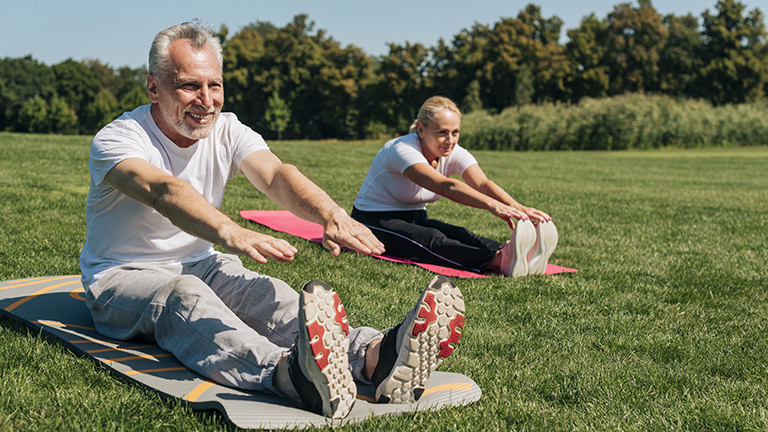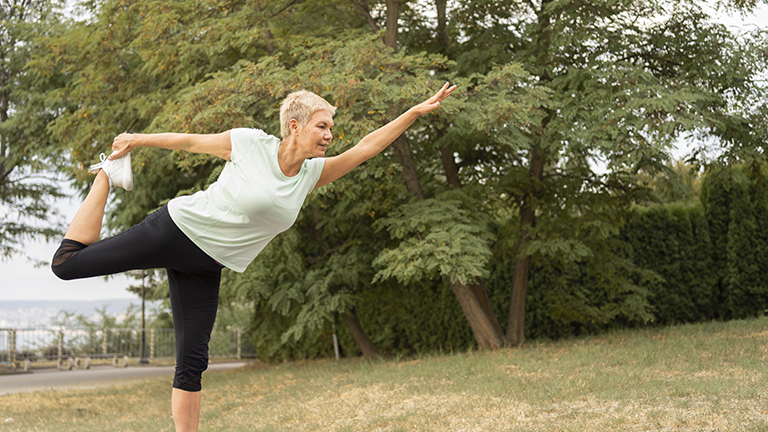Exercises for Seniors to Improve Balance: As we age, maintaining balance becomes one of the most critical aspects of overall health and mobility. Declining balance can significantly increase the risk of falls, leading to injuries, loss of independence, and reduced quality of life. Performing targeted exercises for seniors to improve balance not only enhances physical stability but also strengthens muscles, improves coordination, and boosts confidence in daily activities.
Balance exercises for seniors are essential for maintaining a healthy lifestyle and prolonging independence. Seniors who actively engage in balance training are less likely to experience accidents and are better equipped to handle the challenges of ageing. Moreover, incorporating gentle exercises and functional fitness routines tailored to older adults can lead to long-term health benefits, including improved posture, core strength, and flexibility.
Why Balance Declines with Age
Ageing affects various systems in the body, all of which contribute to balance. Muscle strength naturally decreases, reaction time slows, and joint flexibility diminishes. The vestibular system, responsible for spatial orientation and balance, may also weaken over time. Additionally, age-related conditions such as arthritis, neuropathy, and vision problems further challenge stability.
The combination of these factors makes seniors more susceptible to falls. Even minor missteps can result in severe injuries such as fractures or head trauma. Understanding why balance declines highlights the importance of regular exercises designed specifically to improve stability and coordination for older adults.
Benefits of Improving Balance
Improving balance has multiple benefits for seniors, extending beyond preventing falls. Balance exercises enhance muscle strength, particularly in the legs, hips, and core. They improve coordination, making it easier to perform daily activities like walking, climbing stairs, or carrying groceries. Seniors who practice balance exercises also experience better posture, greater confidence in movement, and enhanced overall quality of life.
Additionally, balance training supports mental well-being by reducing anxiety about falling and promoting independence. It complements other forms of physical activity, such as aerobic exercise and strength training, creating a holistic approach to senior fitness and long-term health.
[INSERT_ELEMENTOR id=”5108″]
Top Balance Exercises for Seniors
Heel-to-Toe Walk
The heel-to-toe walk is a simple yet effective exercise to improve balance and coordination. To perform it, stand with feet aligned heel to toe and slowly walk forward, placing one foot directly in front of the other. Focus on maintaining a straight line while engaging your core muscles.
This exercise challenges stability and strengthens the lower body, particularly the calves and ankles. Regular practice enhances coordination and builds confidence in walking on uneven surfaces. Heel-to-toe walking is suitable for seniors of all fitness levels and can be performed safely indoors or outdoors.
Single-Leg Stands
Single-leg stands are highly effective for enhancing balance and strengthening leg muscles. Stand behind a chair or near a wall for support. Slowly lift one foot off the ground, maintaining stability on the other leg for 10 to 30 seconds. Switch legs and repeat.
This exercise targets the muscles in the hips, thighs, and core while improving coordination and stability. For added difficulty, seniors can perform this exercise with eyes closed or on a soft surface. Single-leg stands are fundamental for fall prevention and can be incorporated into daily routines.
Side Leg Raises
Side leg raises strengthen the hip abductor muscles and improve lateral stability. Stand straight, holding onto a chair for support. Slowly lift one leg to the side without bending the knee, hold for a few seconds, and lower it gently. Repeat on the opposite leg.
This exercise enhances balance by stabilizing the pelvis and improving lower body strength. Consistent practice helps seniors maintain proper alignment while walking and reduces the risk of sideways falls. Side leg raises can be performed multiple times daily for best results.
Heel Raises
Heel raises focus on strengthening the calves and improving ankle stability. Stand behind a chair, feet hip-width apart. Slowly rise onto your toes, hold for a few seconds, then lower your heels back down. Repeat the movement several times.
This exercise improves lower leg strength, contributes to better posture, and enhances overall balance. Heel raises are especially useful for seniors who want to prevent trips and falls while walking or climbing stairs.
[INSERT_ELEMENTOR id=”5108″]
Sit-to-Stand Exercise
The sit-to-stand exercise strengthens the legs and core while promoting functional mobility. Begin seated in a sturdy chair, feet flat on the floor. Slowly rise to a standing position without using your hands, then sit back down with control. Repeat several times.
This exercise mimics daily movements, making it highly functional for seniors. It improves leg strength, balance, and coordination, making everyday tasks such as standing from a chair, getting out of bed, or climbing stairs easier and safer.
Tai Chi for Seniors
Tai Chi is a gentle, flowing exercise that promotes balance, flexibility, and mental relaxation. It involves slow, deliberate movements combined with deep breathing and mindfulness. Regular Tai Chi practice improves stability, coordination, and body awareness, significantly reducing the risk of falls.
For seniors, Tai Chi offers a low-impact, meditative approach to fitness that also enhances strength, flexibility, and posture. Many community centers and senior programs offer classes specifically designed for older adults.
Exercises for Seniors to Improve Balance
| Exercise | Description | Primary Benefits | Difficulty Level | Recommended Frequency |
| Heel-to-Toe Walk | Walk in a straight line placing heel of one foot in front of the toes of the other | Improves coordination, strengthens calves and ankles | Easy | Daily, 5–10 minutes |
| Single-Leg Stands | Stand on one leg while holding a chair for support | Enhances balance, strengthens hips and core | Medium | 3–5 times per week, 10–30 sec per leg |
| Side Leg Raises | Lift one leg to the side while standing, using a chair for support | Strengthens hip abductors, improves lateral stability | Medium | 3–5 times per week, 10–15 reps per leg |
| Heel Raises | Rise onto toes and lower back down | Strengthens calves and improves ankle stability | Easy | Daily, 10–15 reps |
| Sit-to-Stand Exercise | Stand from a seated position without using hands | Builds leg strength, improves functional mobility | Medium | 3–5 times per week, 10–15 reps |
| Tai Chi | Slow, flowing movements with deep breathing | Improves balance, flexibility, and body awareness | Easy–Medium | 2–3 times per week, 20–30 minutes |
| Chair Yoga | Seated yoga poses focusing on flexibility and stability | Enhances core strength, flexibility, and balance | Easy | 3–5 times per week, 15–30 minutes |
| Resistance Band Exercises | Seated or standing exercises using bands | Builds core, leg, and arm strength | Medium | 2–3 times per week, 10–15 reps per exercise |
| Gentle Core Workouts | Pelvic tilts, seated ab crunches, modified planks | Strengthens core, improves posture and balance | Medium | 3–5 times per week, 10–15 reps per exercise |
Low-Impact Workouts to Enhance Stability
Chair Yoga for Balance
Chair yoga adapts traditional yoga poses to a seated or supported position, making it accessible for seniors with limited mobility. It improves flexibility, strengthens core muscles, and enhances balance without putting excessive stress on joints.
Regular chair yoga sessions can improve posture, increase range of motion, and boost confidence in movement. It also provides mental relaxation, reducing stress and promoting overall well-being for seniors.
Resistance Band Exercises
Resistance bands provide gentle yet effective strength training, enhancing muscle tone and stability. Exercises such as seated leg presses, seated rows, and standing side leg lifts using resistance bands strengthen the core, legs, and arms.
Resistance band exercises are versatile, easy to perform at home, and suitable for seniors of varying fitness levels. Consistent use improves coordination, enhances balance, and supports functional movement in daily activities.
Gentle Core Workouts
A strong core is essential for maintaining balance. Gentle core workouts for seniors include seated or standing abdominal exercises, pelvic tilts, and modified planks. These exercises improve posture, stability, and coordination.
Focusing on core strength reduces the risk of falls and supports safe, confident movement in everyday life. Core workouts can be incorporated into short daily sessions for maximum benefit.
Safety Tips for Seniors While Exercising
Using Supportive Equipment
Seniors should use supportive equipment such as chairs, handrails, or resistance bands to reduce the risk of injury. Proper footwear with non-slip soles is also crucial for stability.
Supportive equipment ensures exercises are performed safely, allowing seniors to focus on improving balance without fear of falling.
Avoiding Common Injuries
It is important to start slowly and avoid overexertion. Seniors should perform exercises within their comfort zone and stop immediately if they experience pain, dizziness, or fatigue. Warming up before exercise and cooling down afterward helps prevent strains and injuries.
Consulting a healthcare professional or physical therapist before beginning a new exercise routine is highly recommended, especially for seniors with chronic health conditions or mobility limitations.
How Often Should Seniors Perform Balance Exercises?
For optimal results, seniors should perform balance exercises at least 3 to 5 times per week. Each session can last 15 to 30 minutes, focusing on a combination of strength, flexibility, and coordination exercises.
Consistency is key to improving balance, reducing fall risk, and maintaining independence. Combining balance training with aerobic activities such as walking or swimming can further enhance overall health and fitness for seniors.
Conclusion: Exercises for Seniors to Improve Balance
Maintaining balance is crucial for seniors to lead an active, independent, and fulfilling life. Regular exercises for seniors to improve balance, including heel-to-toe walks, single-leg stands, chair yoga, and Tai Chi, strengthen muscles, enhance coordination, and reduce the risk of falls.
By incorporating low-impact workouts and functional exercises into daily routines, seniors can enjoy better posture, increased confidence, and a higher quality of life. Safety measures, supportive equipment, and consistency are essential to maximise the benefits of balance training.
Balance exercises are more than physical activity—they are an investment in longevity, independence, and well-being. Seniors who prioritise balance and stability not only prevent injuries but also gain the freedom to move confidently through life, enhancing both physical and mental health.
FAQ Exercises for Seniors to Improve Balance
1. What are the best exercises for seniors to improve balance?
The best exercises for seniors include heel-to-toe walks, single-leg stands, chair yoga, Tai Chi, and sit-to-stand exercises. These movements strengthen the legs, core, and improve coordination. For a detailed guide, visit National Institute on Aging: Exercise & Physical Activity.
2. How often should seniors perform balance exercises?
Seniors should aim to perform balance exercises 3–5 times per week, with sessions lasting 15–30 minutes. Consistency helps reduce fall risk and maintain independence. More guidance can be found at American Council on Exercise – Senior Fitness.
3. Can balance exercises prevent falls in seniors?
Yes. Regular balance training strengthens muscles, improves coordination, and enhances stability, significantly reducing the likelihood of falls. Learn more from CDC: Older Adult Fall Prevention.
4. Are chair exercises effective for seniors with limited mobility?
Absolutely. Chair exercises allow seniors to improve balance, flexibility, and core strength safely. They are ideal for those with limited mobility or recovering from injury. Check out Senior Fitness: Chair Exercises.
5. Is Tai Chi suitable for all seniors?
Tai Chi is a low-impact, gentle exercise suitable for most seniors. It improves balance, flexibility, and body awareness, making it highly recommended for fall prevention. More details are available at Tai Chi for Health Institute.
6. What equipment is recommended for senior balance exercises?
Supportive equipment such as chairs, handrails, resistance bands, and non-slip shoes enhances safety and stability during exercises. For a complete guide, see American Heart Association: Senior Fitness Equipment.
7. Can these exercises improve mental well-being?
Yes. Balance exercises like Tai Chi, chair yoga, and gentle core workouts not only strengthen the body but also reduce anxiety about falling and improve confidence, contributing to overall mental well-being. Learn more at Mayo Clinic: Exercise and Mental Health.


